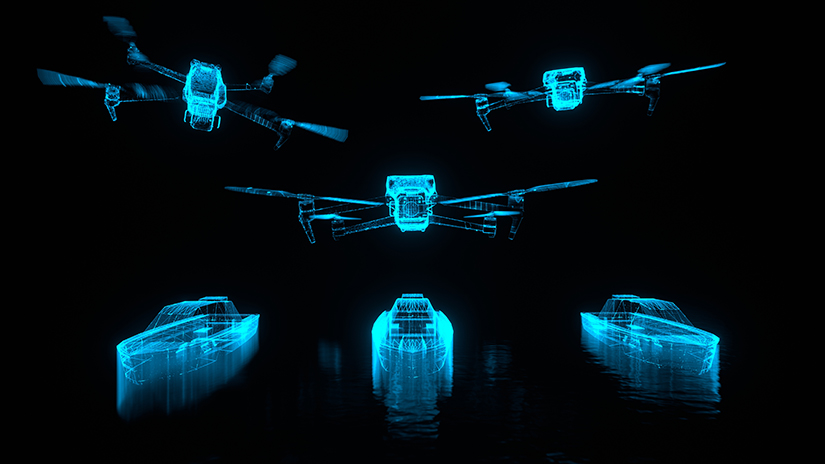Introduction
The People's Liberation Army Navy's (PLAN) new Type 076 amphibious assault ship “Sichuan” was launched at the end of December 2024.[1] The Sichuan is significantly larger than the conventional Type 075 amphibious assault ships and boasts strike power comparable to the U.S. Navy's latest amphibious assault ship. There have also been reports[2] concerning the possibility of using the Sichuan as a small aircraft carrier containing unmanned aerial vehicles, as it is equipped with a launching system featuring an electromagnetic catapult similar to that of the newest aircraft carrier, the Fujian.[3]
In this paper, I analyze the new amphibious assault ship Sichuan and how it is intended to be a joint unmanned special warfare carrier: a command ship carrying special forces, air, surface, and underwater unmanned vehicles that enables special forces to carry out operations together with unmanned vehicles.

Overview of the Type 076 Amphibious Assault Ship Sichuan
The newly launched “Sichuan” was built at the Hudong-Zhonghua Shipbuilding (Group) Co., Ltd. in Shanghai, a subsidiary of China State Shipbuilding Corporation Limited (CSSC), which has previously built several assault landing craft. The Sichuan is the first amphibious assault ship built at the shipbuilder's newly constructed Shanghai Changxing Island shipyard. Analysis of the vessel based on satellite imagery and images from the launching ceremony reveals its size and shape, as well as its two aircraft landing elevators and single vehicle deck. It is similar in some respects to the U.S. Navy’s latest amphibious assault ship. Like its U.S. counterpart, PLAN has focused on landing by aircraft rather than by boats. On the other hand, the Sichuan, due to its emphasis on aircraft use, has expanded aircraft hangar space and also features a well dock equipped with a hovercraft landing craft (Landing Craft Air Cushion: LCAC) and a general-purpose landing craft (Landing Craft Utility: LCU).[4] As a result, it is estimated that landing vehicle space is significantly restricted.
The Sichuan has a smaller displacement than the U.S. Navy’s latest assault ship (Bougainville class), making it difficult for a single ship to carry and land a regiment, which is considered a self-contained formation in amphibious operations. Given that the estimated size of a regiment of the People’s Liberation Army (PLA) special operations forces is 1,000 to 2,000 personnel, it makes military sense to anticipate the use of the Sichuan for special forces, as another use for amphibious assault ships.
The Sichuan is also equipped with an electromagnetic catapult (CATOBAR system), a major feature that no other amphibious assault ship in the world has.[5] The U.S., as well as the U.K., Japan, Spain, and other countries, use vertical takeoff and landing aircraft, so electromagnetic catapults are not necessary, but there are also significant advantages to installing CATOBER systems. First, they can significantly reduce the consumption of aircraft fuel needed for launching and landing vertical takeoff and landing aircraft, thereby extending the range of the aircraft. Second, whereas vertical takeoff and landing aircraft are subject to weight limitations that may prevent them from taking off with a full load of weapons or a full load of fuel, the use of electromagnetic catapults makes it possible to launch heavier aircraft, increasing the potential payload.[6] In other words, CATOBER systems have the advantage of being able to carry more ammunition, missiles, fuel, and other payload, and advance further.
The U.S. Department of Defense and the Center for Strategic and International Studies (CSIS) have noted the potential use of the Sichuan as a giant drone platform.[7] Moreover, based on satellite images of the Sichuan under construction, CSIS believes that if limited to unmanned systems, the air wing on the Type 076 would be very powerful, since China boasts a number of advanced drones including the GJ11 stealth combat drone, the WZ7 reconnaissance drone, and the Caihong Unmanned Combat Aerial Vehicle (UCAV).[8] Images and videos of the tailless delta-wing aircraft (J36) were suddenly posted on Chinese social media on December 26, 2024, to coincide with the launch of the Sichuan, simultaneously introducing two 6th generation fighters.[9] Some have suggested that this implies that the new fighters and drones will also be carried on the Sichuan.[10]
In summary, the above characteristics of the Sichuan could make it a mothership for special forces with unmanned aircraft (air, surface, and underwater).
Table: Comparative Table of Amphibious Assault Ships

Reasons for Building a Joint Unmanned Special Warfare Carrier and Anticipated Tactics
In the event that China deployed the PLA and other forces in a full-scale invasion of Taiwan, it would be necessary to transport a large number of troops and supplies via the Taiwan Strait, requiring a large number of amphibious assault ships and other transport vessels and transport aircraft. To this end, construction of the larger Type 071 amphibious transport dock ships began in 2006, with eight already commissioned and two currently under construction. In addition, construction of the Type 075 amphibious assault ship, featuring a full-length flight deck, began in 2017. Contrary to the original plan to rapidly commission eight ships (building the first three ships at a pace of one per year), the fourth Type 075 ship was finally launched in December 2023 after a two-year gap. Thus, the construction of the amphibious ships needed to prepare for conflict over Taiwan is progressing only slowly, despite the fact that their construction periods and costs are lower than those of combat ships. This is probably partly due to the likelihood that that the mass transportation of PLA troops to the main island of Taiwan in a contingency would be carried out by joint military-civilian vessels under the control of the PLA.[11] The construction of the Sichuan in this context further enhances the military rationale for its design as a vessel for special operations forces rather than mass operational transport.
The PLA special operations forces (SOF) are tasked with three primary missions: direct action, special reconnaissance, and counterterrorism. Their operational objective is to prepare the field for countering conventional forces by attacking critical areas, degrading enemy operational systems and capabilities, and delaying or disrupting enemy operational activities. In conventional warfare, their missions also include disrupting rear force formations and activities, destroying or securing key targets, executing decapitation strikes, and targeting fire support.[12] The PLA SOF comprises experienced officers and enlisted men with a manpower of 20,000 to 30,000 personnel. One SOF regiment consists of 1,000 to 2,000 men, and therefore, one regiment is an appropriate size for deployment using the Sichuan. The SOF involved in an invasion of Taiwan would be the maritime taskforce and airborne special force.[13] Since the PLA possesses unmanned seaplanes, unmanned submersibles and unmanned aircraft, which it is further developing and improving,[14] it is estimated that both forces will be operating with this equipment. The very fact that the Sichuan can be used as a flagship (command post) for the SOF to carry out self-contained special operations makes it more suitable as a joint unmanned special warfare carrier than an amphibious assault ship in carrying out landing operations.
The PLA’s Taiwan encirclement exercises conducted in 2024, comprising Joint Sword-2024A (conducted in May 2024) and Joint Sword-2024B (conducted in October 2024) provide an example of the factors estimated to enhance the military rationale for conducting such special operations. One of the objectives of these exercises was to “strongly contain the Lai Ching-te administration, which China regards as a ‘Taiwan independence faction,’ and the United States, which is strengthening its relations with Taiwan.”[15] It has also been pointed out that the PLA is conducting “long-range force projection” and “ultra-low-altitude invasion” exercises through the mobilization of attack helicopters and transport helicopters.[16] In addition, the PLA has built what appear to be a “mock urban area” and a “mock presidential office building” at training grounds in two locations in China’s Inner Mongolia Autonomous Region that closely resemble the Taipei urban area and Taiwan’s Presidential Office Building, and is conducting exercises at these locations.[17]
These factors would enable a specific operational simulation where, for example, multiple stealthy unmanned aerial vehicles (UAVs) would be launched from the Sichuan, located at sea after information-gathering through analysis of satellite images and human intelligence (HUMINT). These UAVs would conduct more specific reconnaissance and surveillance activities, and at the same time, a large long-range (semi-submerged) UAV carrying an SOF maritime taskforce would be launched to attempt a covert landing from the coast. Under this scenario, in parallel with missile attacks on major air defense forces and air defense radar systems and air strikes by bombers launched from aircraft carriers, a large number of unmanned attack aircraft and aircraft with airborne SOF units on board would be launched from the Sichuan to conduct long-range concentrated force projection and ultra-low-altitude infiltration against special forces infiltration bases. Together with maritime special forces that have landed and are hiding in covert positions, these would execute decapitation strikes against leaders and destroy command functions. This special operation may also be effective in operations to paralyze the command functions of troops on remote islands or in remote areas.
Conclusion
The number of vessels belonging to PLAN has already surpassed that of the U.S. Navy.[18] It is also strengthening its capabilities through cyberattacks and the acquisition of unmanned aircraft. The Sichuan, analyzed in this report, which is likely to be used as a joint unmanned special warfare carrier, also has the potential to become a major force in the future.
In light of these developments by the PLA, Japan’s Self-Defense Forces must take immediate action. Unmanned asset defense capabilities are cited as one of the functions and capabilities required to respond to new ways of warfare under Japan’s National Defense Strategy (December 2022). Moreover, the Self-Defense Forces have acquired almost complete range of amphibious warfare capabilities, but have yet to acquire an amphibious assault ship. The construction of a futuristic amphibious assault ship is reportedly being considered by the Japan Self-Defense Forces. The consideration of such a vessel for use not only in amphibious warfare but also by the Land Self-Defense Force Special Forces Group, the Maritime Self-Defense Force Special Boarding Unit, and as a carrier for unmanned aircraft is an excellent opportunity for Japan to counter China’s joint unmanned special warfare carrier. Going forward, I hope to observe the progressive construction of amphibious assault ships which also takes into account a joint unmanned special warfare carrier.

(2025/03/11)
Notes
- 1 The term “launch” refers to the transition of a naval vessel under construction to a hull state in which it can float on water, and from a land dock to a floating state at sea. The term “commission” is used to describe the completion of a vessel after further rigging on the water. Even after a vessel is commissioned, the crew must be able to use it to the fullest extent before it can be operated. A ship that is ready for operation is called a “warship.”
- 2 "China launches new amphibious assault ship in a race to rival US military," CNN World, December 27, 2024.
- 3 The aircraft carrier Fujian is the third aircraft carrier (the second manufactured domestically) of the Chinese People's Liberation Army Navy (PLAN). It was launched in June 2022 and first tested in May 2024. The Fujian was the first vessel equipped with an electromagnetic catapult. It is expected to be commissioned in 2025.
- 4 Matthew P. Funaiole, Brian Hart, Aidan Powers-Riggs, and Joseph S. Bermudez Jr., “China's Massive Next Generation Amphibious Assault Ship Takes Shape,” CSIS, August 1, 2024; “China Reveals Intel on its Type 076 Carrier ' Sichuan' After Launch," Eurasia Naval Insight.
- 5 Matthew P. Funaiole, et.al., “China's Massive Next Generation Amphibious Assault Ship Takes Shape.”
- 6 The purpose of using short runway takeoffs and landings, even when STOVL aircraft are capable of vertical takeoff and landing, is to conserve fuel and carry as much ammunition as possible.
- 7 U.S. Department of Defense, “Military and Security Developments involving the People's Republic of China 2024,” Annual Report to Congress, December 18, 2024, p48; Matthew P. Funaiole, et.al., “China's Massive Next Generation Amphibious Assault Ship Takes Shape.”
- 8 Matthew P. Funaiole, et.al., “China's Massive Next Generation Amphibious Assault Ship Takes Shape.”
- 9 Gerry Doyle, “Images show novel Chinese military aircraft designs, experts say,” Reuters, December 27, 2024.
- 10 “[Analysis] Latest Stealth Aircraft and a ‘Drone Mothership’: China to Build Up Military in Air and Sea [Sunday Security]," FNN Prime Online(YouTube), January 6, 2025.
- 11 Tomohisa Takei, “Civilian transportation capacity is evolving the capability of the Chinese military forces to invade Taiwan: centered on the evaluation of the US Annual Report,” The Sasakawa Peace Foundation Japan-US-Taiwan Security Research, July 11, 2023; U.S. Department of Defense, “Military and Security Developments Involving the People's Republic of China 2024, Joint Logistic Support Force,” Annual Report to Congress, December 18, 2024, pp. 72-73.
- 12 U.S. Department of Defense, “Military and Security Developments involving the People's Republic of China 2024, Joint Logistic Support Force,” pp. 79-83.
- 13 Ibid.
- 14 See, for example, Liu Xuanzun and Yang Sheng in Zhuhai, “PLA Air Force's mysterious new armed reconnaissance drone makes debut at Airshow China,” Global Times, November 15, 2024, etc.
- 15 Masafumi Iida, “Military Exercises by China Surrounding Taiwan: Characteristics, Aims and Future Prospects,” NIDS Commentary, No. 325, May 28, 2024.
- 16 Ryan Chan, “Video Shows China’s Army Practicing Invasion Tactics,” Newsweek, January 24 , 2025.
- 17 “[Security by Satellite] A Foothold for ‘Short-term Control of Taiwan’... Yomiuri Shimbun Image Analysis,” Yomiuri Shimbun, July 18, 2024.
- 18 “U.S. Wary of Chinese Naval Expansion, Large Difference in Number of Boats Owned,” The Nikkei, August 21, 2024.

